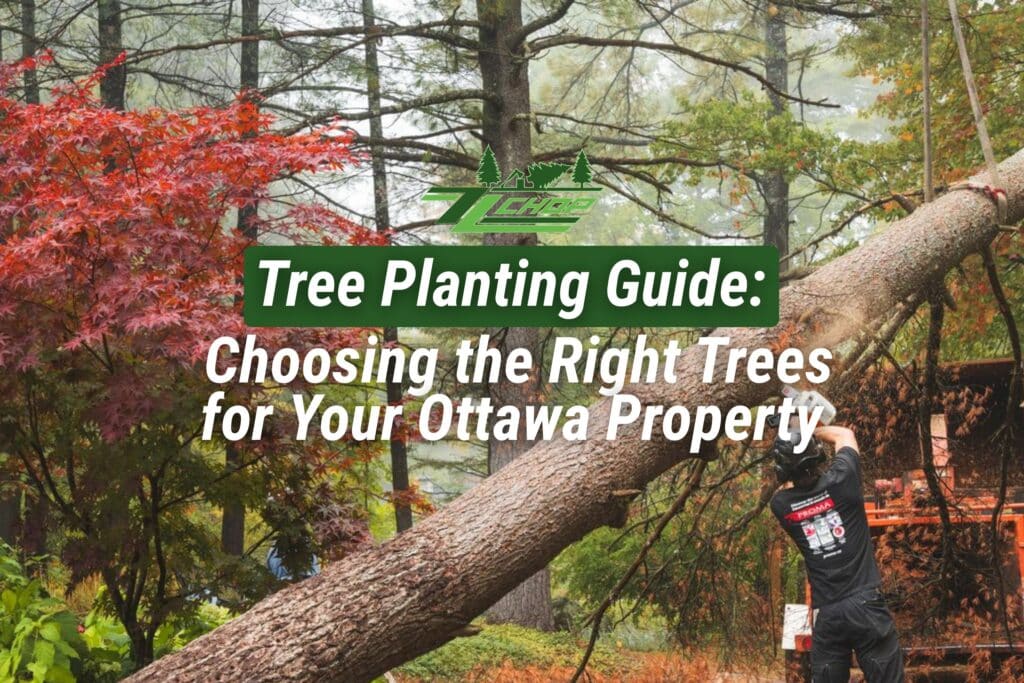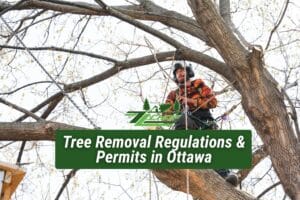Planting trees on your Ottawa property delivers immediate benefits that extend far beyond curb appeal. They also improve air quality and support local wildlife while contributing to Ottawa’s urban forest canopy.
However, poor tree selection and placement often lead to costly problems down the road. Selecting the right trees for your Ottawa property requires understanding our unique climate conditions and soil characteristics.
Trees planted too close to foundations can damage structures, while species unsuited to Ottawa’s climate may require frequent Ottawa tree removal or emergency tree removal Ottawa services. This guide helps you make informed decisions that will enhance your property value and provide decades of enjoyment.
Understanding Ottawa’s Climate and Soil
Ottawa is commonly mapped to about USDA Zone 5b, which corresponds to average annual extreme minimum temperatures of roughly -26.1°C to -23.3°C (-15°F to -10°F). Our continental climate brings hot, humid summers and cold, snowy winters with significant temperature fluctuations.
Most Ottawa properties have clay-heavy soil that retains moisture but can become waterlogged in spring. This soil type affects root development and drainage, making species selection crucial for long-term tree health.
Your tree must withstand ice storms, heavy snow loads, and occasional drought conditions. Native and adapted species typically perform best in these challenging conditions.
Top Tree Recommendations for Ottawa Properties
Large Shade Trees
- Sugar Maple excels in Ottawa’s climate, providing brilliant fall color and excellent shade. These trees adapt well to clay soil and handle winter conditions effectively.
- Red Oak offers strong wind resistance and attractive autumn foliage. Its deep root system prevents surface root problems near walkways and foundations.
- American Elm (disease-resistant varieties) provides classic vase-shaped canopies. Modern cultivars resist Dutch elm disease while maintaining the species’ desirable characteristics.
Medium-Sized Options
- Serviceberry produces spring flowers, summer berries, and fall color. This native species attracts wildlife while requiring minimal maintenance.
- Paper Birch adds visual interest with distinctive white bark. Plant in groups for best effect and improved wind resistance.
- Eastern Redbud blooms early with pink flowers before leaves emerge. Choose Canadian-grown stock for better cold hardiness.
Evergreen Choices
- White Spruce serves as an excellent windbreak or privacy screen. This hardy native handles Ottawa’s climate extremes without issues.
- Eastern White Pine grows quickly and provides year-round interest. Avoid exposed locations where ice damage might occur.
Planting Tips for Success
- Plant in early spring or fall when temperatures moderate and rainfall increases.
- Avoid summer planting unless you can provide consistent irrigation.
- Dig holes twice as wide as the root ball but no deeper. The root flare should sit slightly above ground level to prevent settling and root rot.
- Remove all burlap, wire cages, and rope from the root ball. These materials don’t decompose quickly and can girdle growing roots.
- Water deeply but infrequently during the first growing season. Apply 2-3 inches of mulch around the base, keeping it away from the trunk.
Common Tree Planting Mistakes
Even with the best intentions, many homeowners make simple mistakes that can prevent trees from growing strong and healthy. Proper tree planting is about more than digging a hole — it’s about creating the right environment for long-term growth. Below are some of the most common tree planting mistakes and how to avoid them.
1. Planting Too Deep or Too Shallow
Planting depth is one of the most frequent errors. If a tree is planted too deep, its roots may struggle to get enough oxygen, leading to rot or stunted growth. If it’s too shallow, roots can dry out and fail to anchor the tree properly.
Tip: Always make sure the root flare (the point where the trunk widens at the base) sits right at ground level. The hole should be 2–3 times wider than the root ball but no deeper.
2. Overwatering or Poor Drainage
While young trees need regular watering, too much water can suffocate roots and promote fungal diseases. Poorly drained soil can also trap water around the roots, causing decay.
Tip: Check soil moisture before watering — if the top 2 inches of soil are still damp, wait another day or two. Use well-draining soil and avoid planting in areas that collect standing water.
3. Using Too Much Mulch (“Mulch Volcano”)
Piling mulch up against the tree trunk — often called a mulch volcano — can trap moisture and cause the bark to rot. It also attracts pests and encourages shallow root growth.
Tip: Apply 2–3 inches of mulch in a wide circle around the tree, but keep it a few inches away from the trunk. Think of it as a “mulch donut,” not a volcano.
4. Planting Too Close to Structures
Planting trees too close to houses, fences, driveways, or power lines can lead to major problems as the tree matures. Roots can damage foundations or pipes, and large branches can threaten roofs or windows.
Tip: Always research the mature height and root spread of the tree before planting. Large species like maples and oaks should be planted at least 20–30 feet away from structures.
5. Ignoring Soil Type or Local Climate
Not all trees thrive in all conditions. Planting species that aren’t suited to Ottawa’s cold winters or clay-based soils can result in poor growth or even death within a few seasons.
Tip: Choose cold-hardy, native trees that match your soil type and sunlight conditions. Consulting a local arborist or tree care professional ensures you plant the right species in the right place.
Maintenance and Care
- Young trees need regular watering for their first two years. Deep, weekly watering encourages strong root development better than frequent shallow watering.
- Prune minimally during establishment. Remove only broken, crossing, or dead branches. Major pruning should wait until the tree matures. Learn more about the right time to trim your tree.
- Apply balanced fertilizer sparingly in early spring. Ottawa’s clay soil often contains adequate nutrients, making over-fertilization a common mistake.
- Monitor for common pests like bronze birch borer and diseases such as fire blight. Early detection prevents serious damage.
- Contact certified arborists for large tree installations or complex site conditions. Professional assessment helps avoid costly mistakes with expensive specimen trees.
Fertilization
Proper fertilization plays a vital role in helping trees develop strong roots, vibrant foliage, and long-term resilience — but timing, type, and technique matter. Over-fertilizing or using the wrong formula can harm rather than help your tree, especially when it’s newly planted.
1. When and How to Fertilize New vs. Established Trees
Newly Planted Trees:
Freshly planted trees should not be heavily fertilized right away. Their root systems are still developing, and adding too much fertilizer can burn roots or stimulate top growth before the roots are strong enough to support it.
- Wait about one full growing season (6–12 months) before applying any fertilizer.
- Focus instead on proper watering, mulching, and soil preparation during the first year.
Established Trees:
Once the tree has been in the ground for a year or more, fertilization can help maintain health and encourage steady growth.
- The best time to fertilize established trees is in early spring (April–May) before active growth begins or in late fall (October) after leaf drop but before the ground freezes.
- Apply fertilizer evenly under the tree’s canopy, avoiding direct contact with the trunk.
- Always follow manufacturer instructions — more isn’t better when it comes to fertilizer.
2. Best Fertilizers for Root Development
For young and developing trees, focus on fertilizers that promote root strength rather than rapid leaf growth.
- Use a balanced, slow-release fertilizer such as 10-10-10 (Nitrogen-Phosphorus-Potassium) or one with a slightly higher phosphorus content (the middle number) to support root establishment.
- Organic options like compost, bone meal, or well-rotted manure are excellent for improving soil structure and adding long-term nutrients naturally.
- Apply fertilizer in the root zone — typically just beyond the drip line — to reach the active feeding roots.
3. Avoiding Excessive Nitrogen Early On
Nitrogen is essential for leaf and shoot growth, but too much too soon can lead to problems. Overuse of nitrogen in young trees encourages fast, weak top growth before the roots can properly anchor and support it. This imbalance can make trees susceptible to drought, pests, and wind damage.
Tip: Use fertilizers labeled as “low nitrogen” or “for new plantings” during the first two years. Allow the roots to establish before promoting heavy foliage growth.
Watering and Mulching
Watering and mulching are two of the most important steps in helping newly planted trees establish healthy root systems. Proper moisture management supports root growth, while mulch helps the soil retain water, regulate temperature, and protect roots from damage. However, both need to be done correctly — too much water or mulch can be just as harmful as too little.
1. How Often to Water: First Few Weeks vs. Long-Term Maintenance
Newly Planted Trees (First 4–6 Weeks):
New trees need consistent watering to help roots settle into the soil. During this critical establishment phase:
- Water deeply and slowly every 2–3 days for the first few weeks.
- Aim for 10–15 gallons per watering (roughly one inch of water) to moisten the entire root ball and surrounding soil.
- In hot or dry conditions, increase frequency — shallow, quick watering is less effective than deep soaking.
After Establishment (First Year and Beyond):
Once the roots spread out, reduce watering to once every 7–10 days depending on rainfall.
- Established trees typically need about 1 inch of water per week, either from rain or irrigation.
- In Ottawa’s colder months, gradually reduce watering before the ground freezes to help trees harden off for winter.
Tip: Always water at the base of the tree, not the leaves or trunk, to avoid fungal growth and encourage deep root development.
2. Signs of Overwatering or Underwatering
Overwatering Signs:
- Wilting leaves that remain soft rather than crisp
- Yellowing leaves or early leaf drop
- Fungal growth or a sour smell near the base
- Consistently soggy soil
Underwatering Signs:
- Dry, curling, or brittle leaves
- Slow growth or brown leaf edges
- Soil pulling away from the root ball
- Cracks forming in the soil surface
If you’re unsure, dig 2–3 inches into the soil near the root zone — it should feel slightly moist but not soaked.
3. Mulching: Why It Matters and How to Apply Correctly
Mulching is one of the easiest ways to support healthy trees while improving your landscape’s appearance. It helps the soil retain moisture, suppress weeds, and regulate soil temperature, especially during Ottawa’s hot summers and freezing winters.
How to Apply Mulch Properly:
- Apply a 2–3 inch layer of organic mulch (such as shredded bark, wood chips, or compost) around the base of the tree.
- Extend the mulch at least 2–3 feet from the trunk, ideally reaching the tree’s drip line.
- Keep mulch 2–4 inches away from the trunk to prevent moisture buildup and bark rot — avoid creating a “mulch volcano.”
- Refresh the mulch each spring to maintain an even depth and continue protecting roots.
Tip: Organic mulch slowly decomposes over time, enriching the soil and reducing the need for additional fertilizers.
| Aspect | Details / Tips |
|---|---|
| Planting Depth | Ensure the root collar is level with the soil surface to avoid rot or stress. |
| Soil Preparation | Amend soil with compost or organic matter to improve drainage and nutrient content. |
| Watering Needs | Newly planted trees require consistent watering — generally 10-15 liters per week, more in hot, dry periods. |
| Mulching | Apply 2-4 inches of mulch around the base to retain moisture, suppress weeds, and regulate soil temperature. |
| Survival Rate | Proper planting and care significantly improve tree survival and establishment speed. |
| Climate Consideration | Choose species suited for Ottawa’s cold winters, warm summers, and variable soil conditions. |
| Maintenance | Prune dead or damaged branches, monitor for pests, and adjust watering seasonally. |
| Growth Optimization | Protect young trees from extreme wind, frost, and animal damage for faster, healthier growth. |
| Soil Testing | Test pH and nutrient levels to ensure optimal conditions before planting. |
| Long-Term Care | Fertilize during growth periods, continue mulch replenishment, and perform annual inspections. |
Planting Techniques
Proper planting techniques are crucial for giving your tree the best possible start. Even the healthiest tree can fail to thrive if it’s planted incorrectly. The following steps outline how to plant a tree the right way — from timing and hole preparation to watering and positioning — so it grows strong and healthy for years to come.
1. When to Plant: The Best Season
In Ottawa’s climate, the best times to plant trees are early spring (after the ground thaws) or early fall (before the first frost).
- Spring planting (April–June): Gives trees the full growing season to establish roots before winter.
- Fall planting (September–October): Allows root growth in cool soil while reducing heat stress and watering needs.
Avoid planting in the peak of summer when temperatures are high and soil dries out quickly, as new trees can struggle to establish under heat stress.
2. How to Dig the Hole: Depth and Width
The shape and size of the planting hole are key to successful root development.
- Dig the hole 2–3 times wider than the root ball, but no deeper than its height.
- The goal is to create loosened soil around the hole so roots can spread easily.
- Avoid compacting the bottom of the hole — compacted soil can block root penetration and water flow.
Tip: Before planting, test the depth by placing the tree in the hole — the top of the root ball should sit slightly above ground level.
3. Handling the Root Ball
Proper handling prevents root damage and promotes faster establishment.
- For container-grown trees: Gently remove the pot and loosen circling roots with your hands or a pruning knife.
- For balled-and-burlapped trees: Remove all string, wire baskets, and burlap from the top and sides of the root ball once the tree is positioned in the hole. Leaving them in place can restrict future root growth.
- For bare-root trees: Soak roots in water for 1–2 hours before planting to rehydrate them.
Handle the tree by the root ball, not the trunk, to avoid breakage or stress.
4. Proper Positioning: Root Flare and Orientation
The root flare (the area where the trunk widens at the base) should always be level with the ground or slightly above it. Planting too deep can suffocate roots, while planting too shallow can expose them to drying and instability.
- Align the tree so it stands straight from all angles.
- If planting multiple trees, ensure proper spacing according to their mature size to avoid crowding.
5. Backfilling: Using Native Soil, Not Over-Fertilizing
When backfilling, use the original soil you removed from the hole instead of new, rich soil or heavy compost. Trees need to adjust to their natural environment — using native soil helps roots spread evenly into surrounding ground.
- Gently fill the hole halfway, tamp the soil lightly, then water to remove air pockets.
- Continue filling until the hole is full, shaping the soil surface slightly upward to prevent water pooling.
- Avoid adding fertilizers at this stage — fresh roots can be sensitive to high nutrient levels.
6. Watering Immediately After Planting
Once the tree is planted and the soil is in place, water thoroughly to help settle the soil and remove remaining air pockets.
- Water slowly and deeply so moisture reaches the entire root zone.
- A newly planted tree should receive about 10–15 gallons of water right after planting.
- Afterward, continue a consistent watering routine for the first few months to encourage root establishment.
Growing Success Through Smart Tree Selection
Choosing the right trees for your Ottawa property creates lasting value and beauty. Native and adapted species require less maintenance while providing maximum benefits like shade, privacy, and wildlife habitat. Proper planting techniques and ongoing care ensure your investment thrives for generations.
ZZ ChopTree Care provides expert tree health assessments and maintenance services throughout Ottawa. Our certified arborists can evaluate your property’s specific conditions and recommend appropriate species for your goals.
Professional installation ensures proper planting depth, soil amendments, and initial care protocols. This investment pays dividends through improved survival rates and faster establishment.Ready to plant trees that thrive in Ottawa’s climate? Contact ZZ Chop Tree Care at 343-947-2467 for expert planting advice and comprehensive tree care Ottawa services.
What is the best time to plant trees in Ottawa?
The best time to plant trees in Ottawa is during early spring or fall when the soil is moist and temperatures are moderate, allowing roots to establish before harsh weather.
Why should I hire a professional tree planting service in Ottawa?
Professional tree planting ensures proper depth, soil preparation, and post-planting care — reducing stress on the tree and improving survival rates in Ottawa’s unique climate.
How do I care for newly planted trees in Ottawa?
Newly planted trees need consistent watering, mulch to retain soil moisture, and protection from pests or extreme temperatures for at least the first year.
What types of trees grow best in Ottawa’s climate?
Hardy native species like Sugar Maple, White Pine, and Red Oak are ideal for Ottawa’s climate due to their adaptability to local soil and weather conditions.
How much does professional tree planting cost in Ottawa?
Tree planting costs in Ottawa typically range from $200 to $800 per tree, depending on tree size, species, and site preparation requirements.
How can I improve tree growth and survival after planting?
Using compost-rich soil, watering regularly, and applying mulch around the base help trees establish strong roots and grow healthier over time.
Does ZZ Chop Tree Care offer year-round tree services in Ottawa?
Yes, ZZ Chop Tree Care provides comprehensive tree care throughout the year, including planting, pruning, removal, and seasonal maintenance services across Ottawa.




